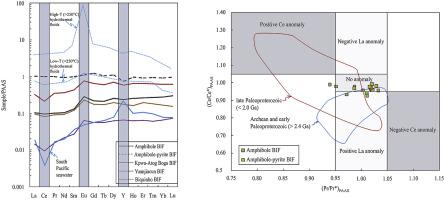Geoscience Frontiers ( IF 8.9 ) Pub Date : 2020-08-25 , DOI: 10.1016/j.gsf.2020.07.009 Landry Soh Tamehe , Chongtao Wei , Sylvestre Ganno , Carlos Alberto Rosière , Jean Paul Nzenti , Chesther Gatse Ebotehouna , Guanwen Lu

|
The discovery of the Gouap banded iron formations (BIFs)-hosted iron mineralization in the northwestern of the Nyong Group (Ntem Complex) in southwestern Cameroon provides unique insights into the geology of this region. In this contribution, we firstly report detailed study of geochemistry, isotopic and geochronology of well preserved samples of the Gouap BIFs collected from diamond drillcores. The Gouap BIFs consist mainly of amphibole BIFs and amphibole–pyrite BIFs characterized by dominant Fe2O3 + SiO2 contents and variable contents of CaO, MgO and SO3, consistent with the presence of amphibole, chlorite, epidote and pyrite, formed during amphibolite facies metamorphism and overprinted hydrothermal event. The amphibole–pyrite BIFs are typically enriched in trace and rare earth elements (REE) compared to the amphibole BIFs, suggesting the influence of detrital materials as well as secondary hydrothermal alteration. The Post Archean Australian Shale (PAAS)-normalized REE–Y profiles of the Gouap BIFs display positive La, Eu anomalies, weak negative Ce anomalies, indicating a mixture of low-temperature hydrothermal fluids and relatively oxic conditions probably under relative shallow seawater.
We present here the first isotopic data of BIFs within the Ntem Complex. The δ30SiNBS28 values of the quartz from the Gouap BIFs vary from −1.5‰ to −0.3‰ and from −0.8‰ to −0.9‰ for the amphibole BIFs and amphibole–pyrite BIFs, respectively. The quartz has δ18OV-SMOW values of 6.8‰–9.5‰ (amphibole BIFs) and 9.2‰–10.6‰ (amphibole–pyrite BIFs). The magnetite from the Gouap BIFs shows δ18O values ranging from −3.5‰ to −1.8‰ and from −3‰ to −1.7‰ for the amphibole BIFs and amphibole–pyrite BIFs, respectively. Moreover, the pyrite grains in the amphibole–pyrite BIFs display δ34S values of 1.1‰–1.8‰. All isotopic data of the Gouap BIFs confirm that they might have precipitated from low-temperature hydrothermal fluids with detrital input distant from the volcanic activity. According to their geochemical and isotopic characteristics, we propose that the Gouap BIFs belong to the Superior type.
In situ U–Pb zircon dating of BIFs was conducted to assess the BIF depositional age based on strong evidence of zircon in thin section. The Gouap BIFs were probably deposited at 2422 ± 50 Ma in a region where sediments extended from continental shelf to deep-water environments along craton margins like the Cauê Formation of the Minas Supergroup, Brazil. The studied BIFs have experienced regional hydrothermal activity and metamorphism at 2089 ± 8.3 Ma during the Eburnean–Transamazonian orogeny. These findings suggest a physical continuity between the protocratonic masses of both São Francisco and Congo continents in the Rhyacian Period.
中文翻译:

喀麦隆西南部Nyong集团的Gouap带状铁层的沉积年龄和构造环境:钻芯样品的同位素,地球化学和地质年代研究的见解
在喀麦隆西南部的Nyong Group(Ntem Complex)西北部,发现了用Gouap带状铁层(BIFs)承载的铁矿化现象,为该地区的地质学提供了独特见解。在这项贡献中,我们首先报告了对从金刚石钻芯收集的保存完好的Gouap BIF样品进行地球化学,同位素和地球年代学的详细研究。Gouap BIF主要由闪石BIF和闪石-黄铁矿BIF组成,其特征在于Fe 2 O 3 + SiO 2占主导地位,CaO,MgO和SO 3含量可变,与闪石岩相变质和叠印的热液事件形成的闪石,绿泥石,山竹和黄铁矿的存在一致。与闪石BIF相比,闪石-黄铁矿BIF通常富含痕量和稀土元素(REE),表明碎屑物质以及二次热液蚀变的影响。Gouap BIF的澳大利亚新时代后页岩(PAAS)归一化REE–Y剖面显示正La,Eu异常,较弱的Ce负异常,表明可能是在相对浅海水中的低温热液和相对有氧的混合物。
我们在此介绍Ntem复杂区内BIF的首个同位素数据。的δ 30的Si NBS28从Gouap的BIF石英的值分别改变从-1.5‰至-0.3‰和从-0.8‰〜-0.9‰,闪石的BIF和角闪石黄铁矿的BIF,。石英具有δ 18 ö V-SMOW 6.8‰-9.5‰(闪石的BIF)和9.2‰-10.6‰(角闪石黄铁矿的BIF)值。从Gouap的BIF表示磁铁矿δ 18个O值范围分别为-3.5‰至-1.8‰和从-3‰至-1.7‰,闪石的BIF和角闪石黄铁矿的BIF,。此外,在角闪石黄铁矿的BIF的黄铁矿颗粒显示δ 34S值为1.1‰–1.8‰。Gouap BIFs的所有同位素数据都证实它们可能是从低温热液中析出的,其碎屑输入与火山活动距离较远。根据它们的地球化学和同位素特征,我们认为Gouap BIF属于上等类型。
根据薄层中锆石的有力证据,对BIF的原位U–Pb锆石定年进行了评估,以评估BIF的沉积年龄。Gouap BIFs可能沉积在2422±50 Ma,该区域的沉积物从大陆架一直延伸到沿克拉通边缘的深水环境,例如巴西米纳斯超群的考伊组。在Eburnean-Transamazonian造山运动期间,所研究的BIF在2089±8.3 Ma处经历了区域热液活动和变质作用。这些发现表明,在Rhyacian时期,圣弗朗西斯科州和刚果大陆的原始克拉通质量之间存在物理上的连续性。



























 京公网安备 11010802027423号
京公网安备 11010802027423号